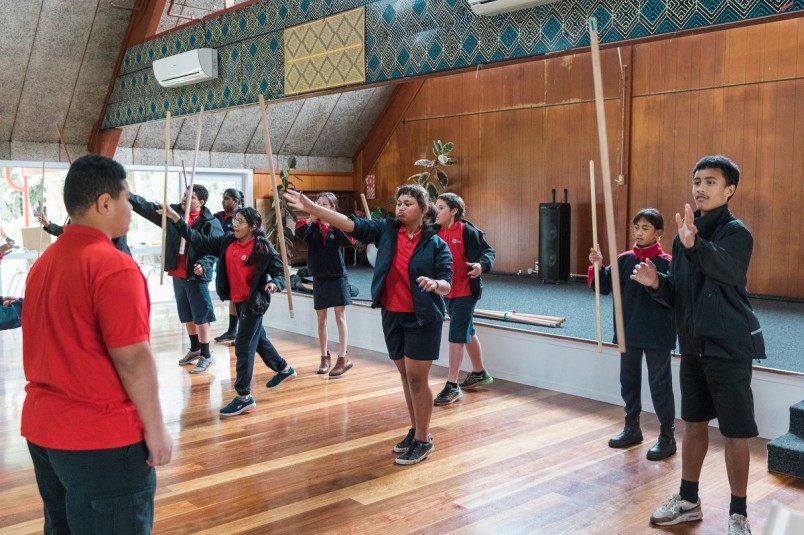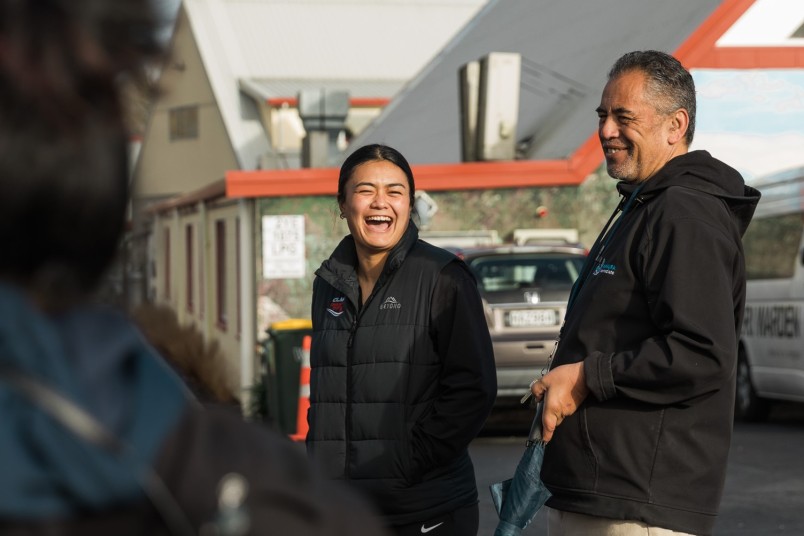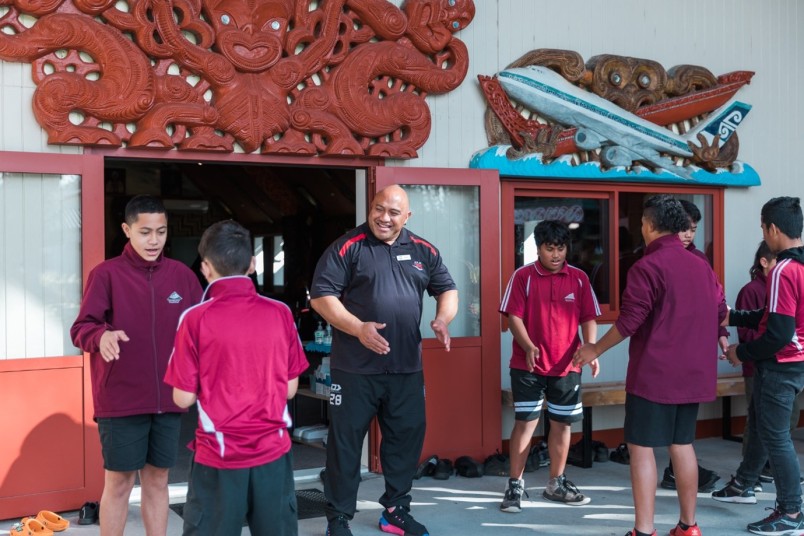Papakura Marae offers 51 community services, including a GP clinic, weekly community dinners, and driving lessons. Now, through a growing collaboration with the Healthy Active Learning team at CLM Community Sport, the urban marae is using the draw of physical activity to connect with schools in the area in new ways.
In term 3 and Papakura Marae formally welcomed on 80 ākonga from four local primary and intermediate schools (the majority within walking distance) for a Matariki celebration.
Following a pōwhiri, the ākonga learned more about the celebration post boil-up in the wharekai and made their way around taonga tākaro (Māori games) stations.
There were ringa kemu (hand games), i te timatanga (rhythm and hand games connected to the pūrakau of Rangi and Papa), whai (string games), tī kouka (Māori play using natural resources), and rakau kemu (stick games).
“For us the marae is that oasis where whānau can feel connected, feel engaged, not be judged, and feel welcome,” says marae CEO Tony Kake.
“In a year we probably deal with over 40,000 people through the marae – of all ages, from hapū tanga through to tangi. We are here to support our community, but most importantly our tamariki for they are the next generation.”

Milestone connection
The day marked an exciting milestone. Although the marae has close relationships with many schools in the area this was the first the time these students had been formally welcomed onto the marae.
The idea to connect ākonga with the marae through physical activity was born from a successful kī-o-rahi pilot the marae ran with CLM Community Sport earlier in the year.
“Through that programme the idea came up about integrating schools here at the marae to inform them, to give them more knowledge, and more confidence about what being on a marae means. What a pōwhiri process is,” says Dee Clark.
Dee is the Whānau Ora team lead at the marae and organised the Matariki event with CLM Healthy Active Learning community connector Shyanne Thompson.
Dee says the importance of the day was to open the doors to tamariki and to say “this is your home too. Come and see us if you need us or tell mum and dad about us. It’s an extension of aroha.”
Shyanne agrees, saying, “I think it’s really important for the tamariki to understand they are really important parts of this community, and they are the centre of everything this marae is about – supporting tamariki and rangatahi.
“Being told from the marae that this is their marae now, this is their whare, and they are welcome here anytime is just really special.”
As a Healthy Active Learning community connector, Shyanne’s role is to support schools to develop quality connections with their community to enhance tamariki wellbeing.
Ultimately how she does that is guided by their wants and needs. And, she says, schools have identified they want to connect with the marae in new ways – through physically spending time on it.
Wiremu Turner, a kaiako at Papakura Intermediate, attended with 20 of his ākonga. The school has an existing relationship with the marae, and Wiremu spoke on behalf of the schools at the pōwhiri, but only a handful students have been on before – and never inside the wharenui.
Wiremu says when schools connect with marae the wellbeing of tamariki is always enhanced.
“Each school has their own way of catering for the wellbeing of their tamariki but when the marae is involved it just takes it a step above.
“It works both ways – for those who really haven’t experienced marae and for those who have but are able to introduce their friends to things we do on marae.”

Ākonga feel the aroha
One of Wiremu’s students, Kaleb (Ngāti Porou), has never been onto Papakura Marae before – although he has spent time on his own in Rotorua.
The 13-year-old says he enjoyed the chance to hang out with his mates on a marae and had fun learning about Matariki through the stories held in the wharenui. He also says that playing games about Matariki helped him learn.
“I enjoyed the string games. And we had some boil up – it was nice. It’s been a cool day.”
He says he would like to come back to the marae and that, when he passed it in the future, he would think about the day and his culture – “which is Māori.”
“I am proud to be Māori and I’ve always lived in Papakura. Papakura will always be my home town.”
Thirteen-year-old George, a student at Ngākōroa School, has never been on marae. He says he has learned that it was about more than “people coming in and just singing and talking to other people.”
“I have found out it’s something more. It’s meeting up with your friends, family, catching up with each other and all that fun stuff.”
He also learned lots of new things about Māori culture – including kupu (words), games, and even a new haka.
He says he would love to come back.
“That would make me feel so great so I can meet up with other people, meet new friends, eat with them, and share all the things that I’ve done.”
For George’s kaiako, Kate Lewis, the opportunity for herself and tamariki to connect with other schools and learn more about the role the marae played in the Papakura community had been a highlight. Particularly as Ngākōroa only opened in 2022.
“It’s just good for the soul to connect. Not only with ourselves and who we are but with the wider community.
“One of our school values is kaitiakitanga. An aspect of that value is being proud of who you are and where you come from and embracing your culture and celebrating and sharing it with the community.”
Kate says Shyanne, who has been supporting the school to create a quality play, sport, and physical activity environment, had been paramount to making the connection with the marae happen.
“I love that Shy saw the natural connection with our school values and the opportunity to embrace that with a marae visit.”
Whakawhanaungatanga
For other schools wanting to build authentic relationships with their local marae, Shyanne says it all comes down to whakawhanaungatanga.
“It’s about putting your hand up, not out. It’s really important to connect with the marae first and sit down and understand their needs and then go from there.”
Dee reiterates the importance of building relationships first.
“Trust us. Just trust us. We are a welcome environment. Come on and have a cup of tea about what we can do for you, how can we help your whānau.
“Personally, I would love to see a regular thing like this, and I think today proved it’s needed.”
Healthy Active Learning is an action under the Child Youth and Wellbeing Strategy. The initiative, between Sport NZ, Te Whatu Ora Health New Zealand, the Ministry of Health, and Ministry of Education, aims to enhance the wellbeing of tamariki and rangatahi through healthy eating and drinking and quality physical activity. To date, it has supported over 900 schools and kura to create healthy and active learning environments and better connections to their community. This story has also appeared in the Education Gazette and on the Sport New Zealand website.
Watch the video: Strengthening communities through physical activity at Papakura Marae
